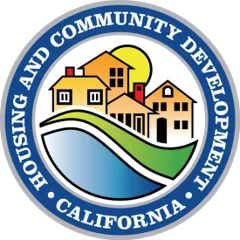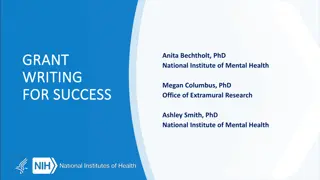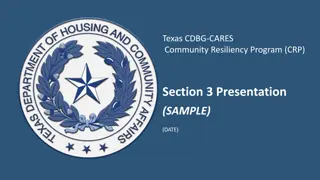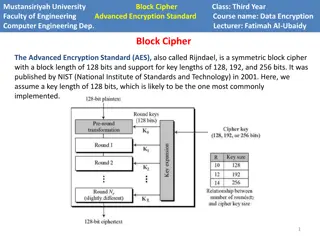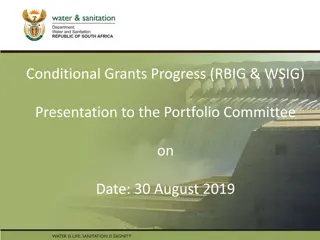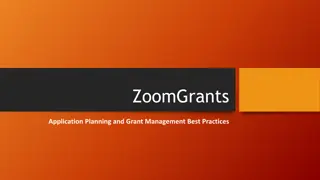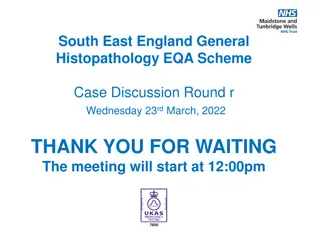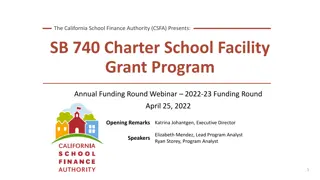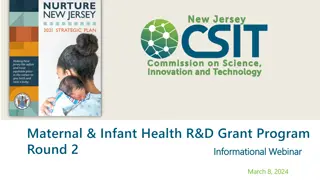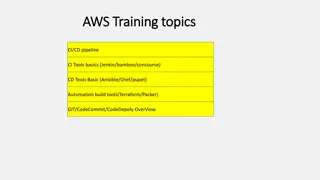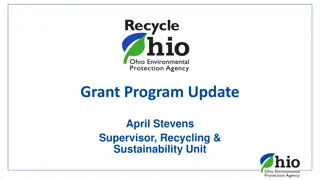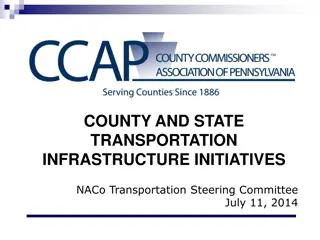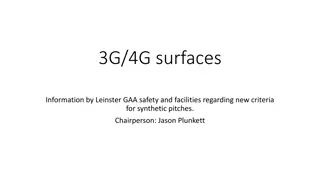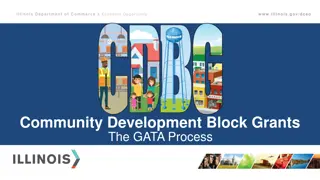Infill Infrastructure Grant Program Round 7 Overview
Infill Infrastructure Grant Program Round 7, funded by the Veterans and Affordable Housing Bond Act of 2018, has a $160 million budget. The NOFA was released on May 12, 2021, with applications due by July 12, 2021. The timeline includes award announcements in early October 2021. Changes in the NOFA guidelines include points for projects in High or Highest Resource Areas and updated definitions related to Fair Housing and project financing. All applicants must now include a Qualifying Infill Project, and construction of housing units must start within two years of the award date.
Download Presentation

Please find below an Image/Link to download the presentation.
The content on the website is provided AS IS for your information and personal use only. It may not be sold, licensed, or shared on other websites without obtaining consent from the author. Download presentation by click this link. If you encounter any issues during the download, it is possible that the publisher has removed the file from their server.
E N D
Presentation Transcript
Infill Infrastructure Grant Program Round 7 Department of Housing and Community Development
Infill Infrastructure Grant Program (IIG) Notice of Funding Availability (NOFA): $160 million Funded by the Veterans and Affordable Housing Bond Act of 2018 (Proposition 1) Applications submitted under these NOFAs are subject to: Proposition 1 IIG Program Guidelines (Guidelines) 2007 Statute (Chapter 2 of Part 12 of Division 31 of the Health and Safety Code (HSC)) The May 12, 2021 NOFA
Round 7 Timeline NOFA released on May 12, 2021 Applications are due July 12, 2021 Award Announcements early October 2021 Standard Agreement approximately 90 days after Award Notification
Whats new in this NOFA and Guidelines Applicants seeking to substitute previously awarded funds must forfeit their prior award prior to the Application due date without assurance of receiving a new award Qualifying Infill Projects (QIPs) located in High or Highest Resource Areas will receive the maximum points Definition of Affirmatively Furthering Fair Housing was added Definitions of Bus Hub and Major Transit Stop were modified Definition of Locality is updated to include the duly constituted governing body of an Indian reservation or rancheria or a Tribally Designated Housing Entity
Whats new in this NOFA and Guidelines (cont.) Applications no longer require a Locality as an Applicant Geographic Targets have been updated Definition of Enforceable Funding Commitment (EFC) now allows for inclusion of both 4 and 9 percent tax credits Applications proposing 4 percent and 9 percent tax credits will be considered equally, allowing Applicants to choose the path that is most likely to fulfill project financing Only commitments for permanent financing are considered
Whats new in this NOFA and Guidelines (cont.) All Applications must include a QIP Internet infrastructure is identified as an Eligible Cost Recipients shall begin construction of the housing units not more than two years from the date of the Program award Recipients shall complete construction of the housing units not more than three years from the date of the Program award Program funds must be disbursed by the Program liquidation date of June 30, 2025. The Recipient must submit final disbursement requests no later than March 31, 2025 Recipients may request an extension of performance requirements
Whats new in this NOFA and Guidelines (cont.) The Selection Criteria for Qualifying Infill Areas (QIAs) was brought into alignment with Selection Criteria for QIPs to ensure a consistent approach to evaluating Applications To incentivize larger scale residential developments, the Multiple QIPs criterion allows full points for QIAs that exceed 250 units The Universal Application and IIG Supplemental Application have been consolidated into a single IIG application Original wet signature documents are no longer required or accepted The entire Application, including supporting documentation, will be submitted electronically
Geographic Targets 45% to Southern California (Kern, San Bernardino, San Luis Obispo, Santa Barbara, Ventura, Los Angeles, Orange, Riverside, and San Diego) 25% to Northern California (Alameda, Contra Costa, Marin, Monterey, Placer, Sacramento, San Francisco, San Mateo, Santa Clara, Santa Cruz, Solano, Sonoma, and Sutter counties) 10% to Central Valley (Fresno, Merced, San Joaquin, Stanislaus, and Tulare) 10% to counties with a population of less than 250,000
Geographic Targets (cont.) Of the total funds available under the NOFA, HCD shall target 10% of total funds, to the extent there are eligible applications, to the following: Emerging Developers: An Applicant where the ownership structure consists of a majority of persons that have been historically disadvantaged due to express or implicit systemic bias or prejudice. BIPOC and BIPOC Project Federally Recognized and Special Government Entities and Properties Indian tribes
Grant Amounts and Limits QIP: QIA: Minimum Grant Amount: $2 million ($1 million for Rural Areas) Maximum Grant Amount: $30 million Minimum Grant Amount: $1.0 million ($500,000 for Rural Areas) Maximum Grant Amount: $7.5 million
Eligible Projects Capital Improvement Projects A Capital Improvement Project (CIP) is the construction, rehabilitation, demolition, relocation, preservation, or other physical improvement of a Capital Asset that is an integral part or necessary for the development of the QIP A CIP is eligible for funding if it is required as a condition of, or approved by the local jurisdiction in connection with its approval of the QIP
Eligible Costs Parks and open space development Utility improvements & relocation Streets, roads, transit linkages and facilities Facilities to support pedestrian & bicycle transit Traffic mitigation, such as street signals Site preparation or demolition Sidewalk or streetscape improvements
Eligible Costs (cont.) Storm drains, storm water basins, culverts, & similar drainage features Required environmental remediation for the CIP, not to exceed 50% of the grant amount Impact fees required by local ordinance for identified eligible CIP (5% of grant amount cap) Parking structures ($50,000 per space cap)
Ineligible Costs Developer fees or profit Housing or mixed-use structures, including the site acquisition Soft costs related to ineligible costs Costs incurred before the deadline for applications or submittal of application In-lieu fees for local inclusionary programs
Eligible Applicants A nonprofit or for-profit Developer of a QIP A city, county, city and county, public housing authority, or redevelopment agency that has jurisdiction over a QIA A city, county, city and county, public housing authority, or redevelopment agency that has jurisdiction over a QIA applying jointly with an owners association The duly constituted governing body of an Indian reservation or rancheria that has jurisdiction over a QIA or a Tribally Designated Housing Entity that is the Developer of a QIP
Eligible Projects What does IIG fund? The CIP A CIP must be an integral part of, or necessary for the development of, either a QIP or housing designated within a QIA
Eligible Projects The QIP or QIA applications must meet all the following conditions: Located in an Urbanized Area Localities must have housing element compliance Include at least 15 percent of Affordable Units Meet the minimum density requirements Located in an area designated for mixed-use or residential development Designate the proposed residential units in the QIP or QIA according to the rules described in the Guidelines Demonstrate the percentage of Affordable and restricted Units Construction shall not have commenced prior to the application deadline
Site Control Examples A fee title Leasehold An enforceable Purchase Option/Lease Option An executed Disposition and Development Agreement (DDA) or irrevocable offer of dedication to a public agency; Right of way or Easement An executed encroachment permit for construction of improvements or facilities within the public right of way or on public land An executed agreement with a public agency Land Sales Contract Other forms of Site Control
Selection Criteria ( 309 & 310) QIP & QIA Project Readiness 100 points Affordability 60 points Density 40 points Access to Transit 20 points Proximity to Amenities 20 points Consistency with Regional Plans 10 points TOTAL 250 POINTS
Selection Criteria ( 309) QIP Project Readiness - 100 points max. Environmental review (30 pts) Land use entitlements (30 pts) Leveraged Funding commitments (20 pts) Leveraged Enforceable Funding Commitments points are awarded based on the percent of Permanent Financing of the total development cost, less deferred costs Local support (12 pts) Prohousing Policies (8 pts)
Selection Criteria ( 310) QIA Project Readiness - 100 points max. Multiple QIPs (10 pts) Environmental review (25 pts) Land use entitlements (25 pts) Leveraged Funding commitments (20 pts) Local support (12 pts) Prohousing Policies (8 pts)
Environmental Review 309(a)(1) & 310(a)(2) QIP & QIA Environmental Review Status (30 pts max. for QIPs and 25 pts max. for QIAs) CEQA and NEPA compliance (30 pts for QIPs and 25 pts for QIAs) Project-based vouchers are the only subsidy triggering NEPA review, completed NEPA review is not required to obtain full readiness points Issuance of public notice of the availability of a draft environmental impact report, negative declaration, or environmental assessment (15 pts)
Environmental Review 310(a)(2) QIA (Cont.) A draft of a program, master or tiered environmental impact report has been completed and filed with the appropriate agency and the developments included in the application will constitute subsequent projects subject to environmental review (10 pts) Not less than 50 percent of the land area is on sites that have been subject to a Phase 1 Site Assessment within one year prior to the application due date (5 pts)
Land Use Entitlement Status 309(a)(2) & 310(a)(3) QIP & QIA Land Use Entitlements (30 pts max. for QIPs and 25 pts max. for QIAs) All necessary discretionary local land use approvals have been granted (30 pts for QIPs and 25 pts for QIAs) QIP/QIA is consistent with all relevant local planning documents and zoning ordinances and applications for all necessary discretionary local land use approvals have been submitted and deemed complete by the appropriate local agencies (15 pts) QIP/QIA is eligible to receive all necessary local land use approvals pursuant to a Nondiscretionary Local Approval Process (10 pts)
Leveraged Funding Commitments 309(a)(3) & 310(a)(4) QIP & QIA Leveraged Funding Commitments (20 pts max.) Rental Housing & Ownership Developments 90% of total development costs (20 pts) 75% of total development costs (10 pts) Commitments must include: Borrower s name Project name (if any), address, APN, legal description, the amount, interest rate, terms of financing May be conditioned on standard underwriting criteria Must contain the word commitment . Examples that are not acceptable is willingness to process an application.. of subject to senior management approval
Leveraged Funding Commitments 309(a)(3) & 310(a)(4) QIP & QIA (Cont.) Applications designating both rental and ownership units will be awarded points on the funding commitments for the QIP/QIA on a percentage basis in proportion to the number of rental and ownership units Example: In a 100-unit development consisting of 80 rental units and 20 ownership units, the number of points will be weighted 80 percent for the funding commitments associated with the rental units and 20 percent for the funding commitments associated with the ownership units, then the respective scores for each component will be combined, not to exceed 20 points
Local Support 309(a)(4) & 310(a)(5) QIP & QIA Local Support (12 pts max.) 25% of IIG request from a local public agency for QIP/QIA or CIP (12 pts) 15% of IIG request from a local public agency for QIP/QIA or CIP (3 pts) Local fee waivers and verified land donations value of the Land Donation will be the greater of either the original purchase price or the current appraised value as supported by an independent third- party appraisal accepted Conditionally reserved federal or state program awarded funds administered by locality (e.g. HUD Continuum of Care (COC), CDBG, HOME) Additional debt supported by project-based vouchers committed to a Project through the Locality
Prohousing Policies 309(a)(5) & 310(a)(6) QIP & QIA Prohousing Policies (8 pts max.) Projects located in jurisdictions that have: Implemented programs over the last five years that finance infrastructure (4 pts) Adopted a Nondiscretionary Local Approval Process for residential and mixed-use development (4 pts) Zoned more sites for residential development (4 pts) Adopted accessory dwelling unit ordinances (4 pts) Only use objective design standards (4 pts)
Multiple QIPs 310(a)(1) QIA Multiple QIPs (10 pts max.) QIAs with three or more QIPs that provide a minimum of 250 new or rehabilitated housing units and can secure all land use entitlements required for construction, or that all applications required for construction have been submitted under a Nondiscretionary Local Approval Process (10 pts) QIAs with two QIPs that provide a minimum of 150 new or rehabilitated housing units and can secure all land use entitlements required for construction, or that all applications required for construction have been submitted under a Nondiscretionary Local Approval Process (5 pts)
Affordability 309(b) & 310(b) QIP & QIA Affordability (60 pts max.) The percentage of units in the QIP/QIA restricted to occupancy by various income groups
Affordability 309(b) & 310(b) QIP & QIA (cont.) Points generated from the Unit Mix on the Eligible Units & Max Funds tab of the application: 0.3 pts for each percent of the total units restricted to the moderate-income 0.8 pts for each percent of the total units restricted to the lower income limit 0.4 pts for each percent of the total units restricted to less than 50% AMI 2 pts for each percent of the total units restricted to less than 30% AMI MHP affordability scoring
Density 309(c) & 310(c) QIP & QIA Density (40 pts max.) Net Density will be scored based on the extent to which the Net Density of the QIP/QIA exceeds the required density: Net Density means the total number of dwelling units per acre of land to be developed for residential or mixed use, excluding allowed deductible areas Net Density will be adjusted by unit size Net Density is not the residential footprint or areas only All density calculations, including exclusions, must be evidenced by a licensed CA professional
Access to Transit 309(d) & 310(d) QIP & QIA Access to Transit (20 pts max.) Points will be awarded based on the proximity of, or accessibility to a Transit Station or Major Transit Stop: mile (20 pts) mile and located in an area of high segregation and poverty or low resource opportunity area or disadvantaged community (15 pts) mile (10 pts) Must be a walkable route boundary to boundary, as IIG defined
Access to Opport. & Prox. to Amenities 309(e) & 310(d) QIP & QIA Access to Opportunity and Proximity to Amenities (20 pts max.) A QIP/QIA is located: In a High or Highest Resource Area as specified on TCAC/HCD Opportunity Area Maps (20 pts) Within mile of a Park ( mile for Rural projects) (5 pts) or mile (1 mile for Rural Area projects) (3 pts) Within 1 mile of a locally recognized Employment Center (2 miles for Rural projects) (5 pts), or 2 miles (4 miles for Rural projects) (3 pts) Within 1 mile of a locally recognized Retail Center (2 miles for Rural projects) (5 pts), or 2 miles (4 miles for Rural projects) (3 pts) Within mile of a public school or community college ( mile for Rural projects) (5 pts), or mile (1 mile for Rural projects) (3 pts) Within mile of a social service facility (5 pts), or 1 mile (3 pts)
Regional Plans 309(f) & 310(f) QIP & QIA Consistency with Regional Plans (10 pts max.) QIP/QIA supports the implementation of a sustainable communities strategy or alternative planning strategy to achieve the region's greenhouse gas emissions target (5 pts) QIP/QIA supports a regional plan that includes policies and programs to reduce greenhouse gas emissions (If a sustainable community s strategy is not required for a region by law) (5 pts) QIP/QIA in which not less than 50 percent of the land area is within a Transit Priority Area (5 pts)
Tie-Breaker Criteria Lowest ratio between the grant request and the maximum calculated grant calculation (10 pts) For each previously awarded QIP developed by the Eligible Applicant that has received a certificate of occupancy by the deadline for submittal of Applications set forth in this NOFA (3 pts)
Application Requirements IIG Application Summary Please do not copy and paste information into the worksheet cells as this could have a negative impact on any hidden formulas or macros Complete tabs in order, as tabs are linked Provide all relevant information verify with application checklist Label documents according to FAAST Instructions
Application Requirements
Application Support Ask questions before the HCD application deadline post deadline, only clarifying information may be added Email sample application scenarios to HCD Schedule a TEAMS video conference with HCD to review your project and application questions For application help or questions please use the application support tab in the application and email to appsupport@hcd.ca.gov Submit questions to Infill@hcd.ca.gov and don t forget to review the IIG Question and Answer section Previous applications are available through FAA$T
Team Contacts Sherri Kerth (Program Rep.) sherri.kerth@hcd.ca.gov Paul Dulai (Program Manager) ampritpal.dulai@hcd.ca.gov Fred Rogers (Program Rep.) fred.rogers@hcd.ca.gov Jim Claybaugh (Program Manager) jim.claybaugh@hcd.ca.gov Sheila Anadon (Program Rep.) sheila.anadon@hcd.ca.gov Aleksandra Djurasovic (Program Specialist) aleksandra.djurasovic@hcd.ca.gov Tim Stoecklein (Program Rep.) tim.stoecklein@hcd.ca.gov Debra Taylor (Program Rep.) debra.taylor@hcd.ca.gov Patti Jones (Program Rep.) patricia.jones@hcd.ca.gov
Contact Us! Infill Infrastructure Grant Program 2020 W. El Camino Avenue, Suite 650 Sacramento, CA 95833 (916) 263-2771 Infill@hcd.ca.gov https://www.hcd.ca.gov/grants-funding/active- funding/iigp.shtml

 undefined
undefined
